Live Recording
See the following youtube video for a live demo recording.
Overview
Today we are going to look at a common use case around resource management in Azure, how to manage our resource decommissions more effectively, and even having the ability for our users to self serve a resource decommission by simply using an Azure tag, and also be able to track decommissions or failed decommissions using a tracker table (Azure table storage).
We can ease the management of handling our resource decommissions by simply using Tags and automate the decommission process using an Azure serverless Function App with Powershell as the code base set on a daily run trigger. We will also utilize the Funtion Apps own storage account to create two tables. One called Tracker to track successful decommissions by resource ID and date of decommission, and also a table called Failed in which we will track failed decommissions. Say for example if a resource had a resource lock on it or some sort of other failure that does not allow our automation to successfully complete the decommission task.
So in this demo I will be using a Resource Tag called Decommission. The value will be a date format of dd/MM/yyyy.
| Tag Key | Tag Value |
|---|---|
| Decommission | dd/MM/yyyy |
The idea is simple, place the Decommission tag on the resource OR resource group that you would like to decommission as well as the date that you want that decommission to take place on. The function app will run on a daily Cron schedule and search resources/resource groups that are tagged with the Decommission key and evaluate based on the current Date whether the decommission should be initiated or not, and also track the decommission by recording the event into an Azure Storage Account Table with the resource ID and date of the successful/failed decommission, so that we can track and audit our automated events.
Pre-Requisites
To set up everything we need for our function app I wrote a PowerShell script using AZ CLI, that would build and configure all the things needed. There was one manual step however I will cover a bit later on. But for now you can find the script I used on my github code page called Azure-Pre-Reqs.ps1.
First we will log into Azure by running:
az login
After logging into Azure and selecting the subscription, we can run the script that will create all the resources and set the environment up:
## code/Azure-Pre-Reqs.ps1
#Log into Azure
#az login
# Setup Variables.
$randomInt = Get-Random -Maximum 9999
$subscriptionId=$(az account show --query id -o tsv)
$resourceGroupName = "Automated-Resource-Decommissioning"
$storageName = "decomfuncsa$randomInt"
$tableName = "Tracker"
$tablePartition = "Decommissioned"
$functionAppName = "decomfunc$randomInt"
$region = "uksouth"
$scopes = "$subscriptionId" #Array of Subscriptions that will be covered by automate decommissioning e.g: "$subscriptionId1, $subscriptionId2"
# Create a resource resourceGroupName
az group create --name "$resourceGroupName" --location "$region"
# Create an azure storage account for function app
az storage account create `
--name "$storageName" `
--location "$region" `
--resource-group "$resourceGroupName" `
--sku "Standard_LRS" `
--kind "StorageV2" `
--https-only true `
--min-tls-version "TLS1_2"
# Create a Function App
az functionapp create `
--name "$functionAppName" `
--storage-account "$storageName" `
--consumption-plan-location "$region" `
--resource-group "$resourceGroupName" `
--os-type "Windows" `
--runtime "powershell" `
--runtime-version "7.2" `
--functions-version "4" `
--assign-identity
#Configure Function App environment variables:
$settings = @(
"Function_Scopes=$scopes"
"Function_RGName=$resourceGroupName"
"Function_SaActName=$storageName"
"Function_TableName=$tableName"
"Function_TablePartition=$tablePartition"
)
$settings | foreach-object {
az functionapp config appsettings set --name "$functionAppName" --resource-group "$resourceGroupName" --settings """$_"""
}
# Authorize the operation to create the tracker table - Signed in User
az ad signed-in-user show --query id -o tsv | foreach-object {
az role assignment create `
--role "Reader and Data Access" `
--assignee "$_" `
--scope "/subscriptions/$subscriptionId/resourceGroups/$resourceGroupName/providers/Microsoft.Storage/storageAccounts/$storageName"
az role assignment create `
--role "Storage Table Data Contributor" `
--assignee "$_" `
--scope "/subscriptions/$subscriptionId/resourceGroups/$resourceGroupName/providers/Microsoft.Storage/storageAccounts/$storageName"
}
#Create Tracker Table in Function storage acc
Start-Sleep -s 15
$storageKey = az storage account keys list -g $resourceGroupName -n $storageName --query [0].value -o tsv
az storage table create `
--account-name "$storageName" `
--account-key "$storageKey" `
--name "$tableName"
#Create Table in Function storage to track failed decommissions
az storage table create `
--account-name "$storageName" `
--account-key "$storageKey" `
--name "Failed"
#Assign Function System MI permissions to Storage account(Read) and table(Write) and contributor to subscription to be able to do decommissions
$functionMI = $(az resource list --name $functionAppName --query [*].identity.principalId --out tsv)| foreach-object {
az role assignment create `
--role "Reader and Data Access" `
--assignee "$_" `
--scope "/subscriptions/$subscriptionId/resourceGroups/$resourceGroupName/providers/Microsoft.Storage/storageAccounts/$storageName"
az role assignment create `
--role "Storage Table Data Contributor" `
--assignee "$_" `
--scope "/subscriptions/$subscriptionId/resourceGroups/$resourceGroupName/providers/Microsoft.Storage/storageAccounts/$storageName"
az role assignment create `
--role "Contributor" `
--assignee "$_" `
--subscription "$subscriptionId"
}
NOTE: In the Azure-Pre-Reqs.ps1 script, the following variable $scopes will determine which scopes the decommission function will search for resources to decommission.
## code/Azure-Pre-Reqs.ps1#L13-L13
$scopes = "$subscriptionId" #Array of Subscriptions that will be covered by automate decommissioning e.g: "$subscriptionId1, $subscriptionId2"
Lets take a closer look, step-by-step what the above script does as part of setting up the environment.
- Create a resource group called
Automated-Resource-Decommissioning.
- Create an azure storage account for the function app.
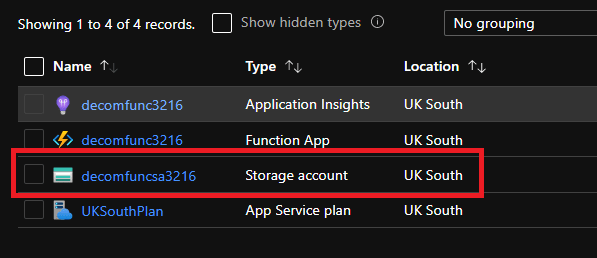
- Create a PowerShell Function App with
SystemAssignedmanaged identity,consumptionapp service plan andinsights.
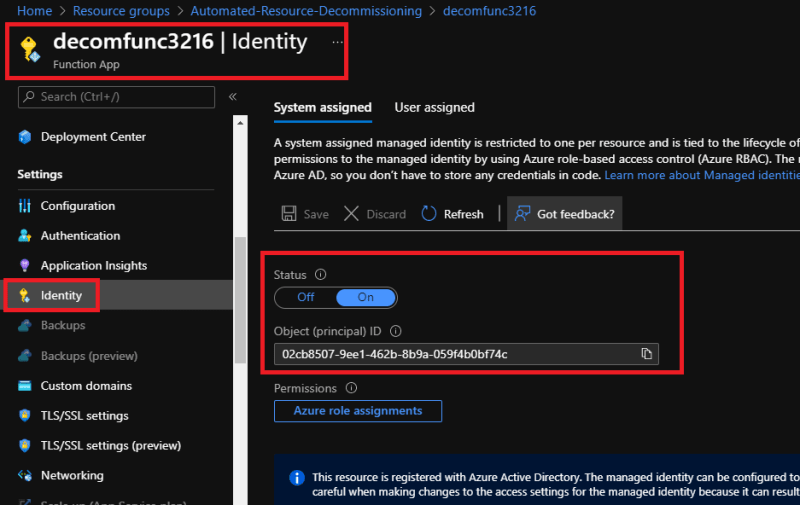
- Configure Function App environment variables. (Will be consumed inside of function app later).

- Create
TrackerandFailedstorage tables in the function apps storage account.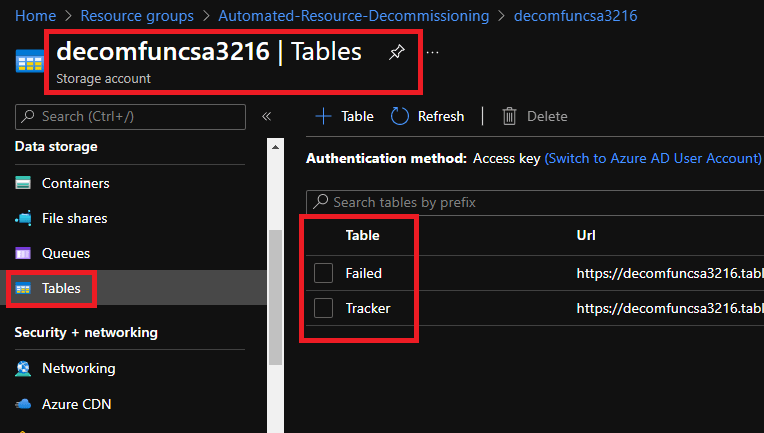
- Assign Function App
SystemAssignedmanaged identity permissions to Storage account(Read), table(Write) and subscription(Contributor).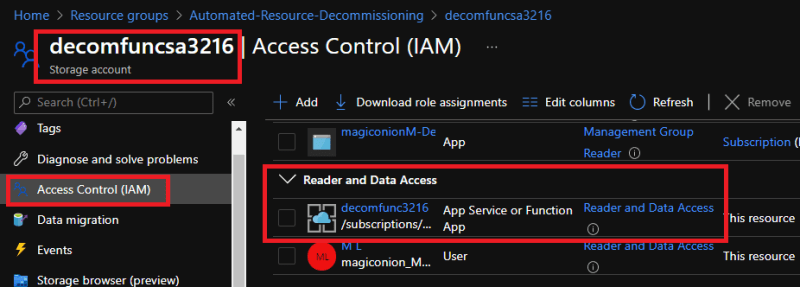

- Remember I mentioned earlier there is one manual step. In the next step we will change the
requirements.psd1file on our function to allow theAZmodule inside of our function by uncommenting the following, as well as adding a module to be installed calledAzTable
# This file enables modules to be automatically managed by the Functions service.
# See https://aka.ms/functionsmanageddependency for additional information.
#
@{
# For latest supported version, go to 'https://www.powershellgallery.com/packages/Az'.
# To use the Az module in your function app, please uncomment the line below.
'Az' = '7.*'
'AzTable' = '2.*'
}
NOTE: Remember to save the manual change we made on requirements.psd1 above. Our environment is now set up and in the next section we will configure the function to run automated decommissions and schedule a timer.
Decommission Function
The following function app code can also be found under my github code page called run.ps1.
- Navigate to the function app we created in the previous section and select
+ CreateunderFunctions.
- Select
Develop in portaland for the template selectTimer trigger, name the functionResourceDecommission, set the cron schedule to run on the frequency you need (in my case I have set this to once a day at 23:55pm)0 55 23 * * *, and hitCreate.
NOTE: You can change the cron timer trigger anytime by going to the functions Integration section. 
- Navigate to
Code + Testand replace all the code underrun.ps1with the following powershell code and hitsave: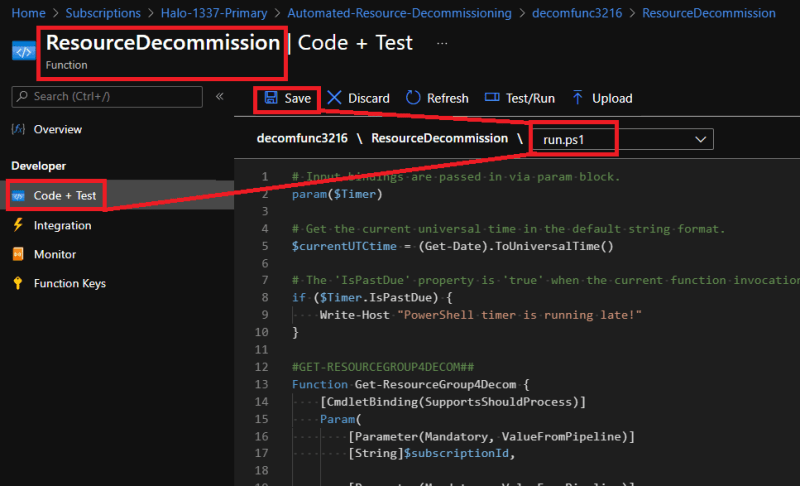
## code/run.ps1
# Input bindings are passed in via param block.
param($Timer)
# Get the current universal time in the default string format.
$currentUTCtime = (Get-Date).ToUniversalTime()
# The 'IsPastDue' property is 'true' when the current function invocation is later than scheduled.
if ($Timer.IsPastDue) {
Write-Host "PowerShell timer is running late!"
}
#GET-RESOURCEGROUP4DECOM##
Function Get-ResourceGroup4Decom {
[CmdletBinding(SupportsShouldProcess)]
Param(
[Parameter(Mandatory, ValueFromPipeline)]
[String]$subscriptionId,
[Parameter(Mandatory, ValueFromPipeline)]
[String]$ResourceGroupName,
[Parameter(Mandatory=$false, ValueFromPipeline)]
[ValidateSet('Decommission')]
[String]$TagKey='Decommission',
[Parameter()]
[Switch]$Future
)
#Set context and Get date and format
$null = Set-AzContext -Subscription $subscriptionId
$date = get-date -format dd/MM/yyyy
#Get Resource Object and Tags
$objResourceGroup = Get-AzResourceGroup -Name $ResourceGroupName -ErrorAction SilentlyContinue
$objTags = $objResourceGroup.Tags
#Get the matching key and value provided
If(!$Future) {
If ($objTags.Keys -contains $TagKey) {
$tagValue = $objTags["$TagKey"]
If (($tagValue -lt $date) -or ($tagValue -eq $date)) {
$ResourceGroup = $objResourceGroup
}
return $ResourceGroup
}
}
Else {
If ($objTags.Keys -contains $TagKey) {
$tagValue = $objTags["$TagKey"]
If ($tagValue -gt $date) {
$ResourceGroup = $objResourceGroup
}
return $ResourceGroup
}
}
}
#GET-RESOURCE4DECOM##
Function Get-Resource4Decom {
[CmdletBinding(SupportsShouldProcess)]
Param(
[Parameter(Mandatory, ValueFromPipeline)]
[String]$ResourceId,
[Parameter(Mandatory=$false, ValueFromPipeline)]
[ValidateSet('Decommission')]
[String]$TagKey='Decommission',
[Parameter()]
[Switch]$Future
)
#Determine resource Subscription and set context
$subscription = $ResourceId.Split("/")[2]
$date = get-date -format dd/MM/yyyy
#Get Resource Object and Tags
$objResource = Get-AzResource -ResourceId $ResourceId -ErrorAction SilentlyContinue
$objTags = $ObjResource.Tags
#Get the matching key and value provided
If(!$Future) {
If ($objTags.Keys -contains $TagKey) {
$tagValue = $objTags["$TagKey"]
If (($tagValue -lt $date) -or ($tagValue -eq $date)) {
$Resource = [pscustomobject]@{Subscription = (Get-AzSubscription -SubscriptionId $subscription).Name;
ResourceGroup = $ObjResource.ResourceGroupName;
ResourceType = $ObjResource.ResourceType;
ResourceID = $ObjResource.ResourceId;
ResourceName = $ObjResource.Name;
DecommissonDate = $objTags["$TagKey"]
}
return $Resource
}
}
}
Else {
If ($objTags.Keys -contains $TagKey) {
$tagValue = $objTags["$TagKey"]
If ($tagValue -gt $date) {
$Resource = [pscustomobject]@{Subscription = (Get-AzSubscription -SubscriptionId $subscription).Name;
ResourceGroup = $ObjResource.ResourceGroupName;
ResourceType = $ObjResource.ResourceType;
ResourceID = $ObjResource.ResourceId;
ResourceName = $ObjResource.Name;
DecommissionDate = $objTags["$TagKey"]
}
return $Resource
}
}
}
}
###Decom Section####
##Needed modules##
#Install-Module AzTable -force
Import-Module AzTable
# Set these environment variables up in Function App settings:
$scopes = $env:Function_Scopes.Split(', ') #SubscriptionIds to scan for decommissions
$resourceGroupName = $env:Function_RGName #Function RG name (for tracking)
$storageAccountName = $env:Function_SaActName #Function SA Acc Name (for tracking)
$trackingTableName = $env:Function_TableName #Table storage (Tracker)
$trackingTablePartition = $env:Function_TablePartition #Table partition (Decommissioned)
#Set Tracker context
$storageAccount = Get-AzStorageAccount -ResourceGroupName $resourceGroupName -Name $storageAccountName
$storageContext = $storageAccount.Context
#Get Resource Groups to Decom
$MatchedResourceGroups = @()
Foreach ($scope in $scopes){
$null = Set-AzContext -Subscription $scope
$ResourceGroupNames = (Get-AzResourceGroup).ResourceGroupName
Foreach ($rg in $resourceGroupNames) {
$MatchedResourceGroups += (Get-ResourceGroup4Decom -SubscriptionId $scope -ResourceGroupName $rg).ResourceId
}
}
#Decom Resource Groups
Foreach ($rID in $MatchedResourceGroups | Where-Object {$_ -ne $null}) {
Write-Host "Decommissioning: $rID"
$Resource = $rID.Replace("/", ":")
Remove-AzResource -ResourceId $rID -Force -ErrorAction Continue
If($?){
$cloudTable = (Get-AzStorageTable -Name $trackingTableName -Context $storageContext).CloudTable
Add-AzTableRow -Table $cloudTable -PartitionKey $trackingTablePartition -RowKey $Resource
} else {
$failureMessage = $error[0].Exception.message.ToString()
Write-Host $failureMessage
$cloudTable = (Get-AzStorageTable -Name "Failed" -Context $storageContext).CloudTable
Add-AzTableRow -Table $cloudTable -PartitionKey "Failed-Decommission" -RowKey $Resource
}
}
#Get Resources to Decom
$ResourceIds = @()
Foreach ($Scope in $scopes){
$null = Set-AzContext -Subscription $Scope
$ResourceIds += Get-AzResource | Select-object ResourceId
}
$MatchedResources = @()
Foreach ($Id in $ResourceIds) {
$MatchedResources += (Get-Resource4Decom -ResourceId $Id.ResourceId).ResourceID
}
#Decom Resources
Foreach ($rID in $MatchedResources | Where-Object {$_ -ne $null}) {
Write-Host "Decommissioning: $rID"
$Resource = $rID.Replace("/", ":")
Remove-AzResource -ResourceId $rID -Force -ErrorAction Continue
If($?){
$cloudTable = (Get-AzStorageTable -Name $trackingTableName -Context $storageContext).CloudTable
Add-AzTableRow -Table $cloudTable -PartitionKey $trackingTablePartition -RowKey $Resource
} else {
$failureMessage = $error[0].Exception.message.ToString()
Write-Host $failureMessage
$cloudTable = (Get-AzStorageTable -Name "Failed" -Context $storageContext).CloudTable
Add-AzTableRow -Table $cloudTable -PartitionKey "Failed-Decommission" -RowKey $Resource
}
}
Lets take a closer look at what this code actually does. In the first few lines we can see that the function app will take an input parameter called $Timer. This parameter is linked to the cron timer we set when we created the function app earlier.
Next we are loading two Powershell functions, one that will evaluate and return Resources to be decommissioned and another to return Resource Groups to be decommissioned. You can look at each of these PowerShell functions individually on my GitHub code page as well. Get-Resource4Decom.ps1 and Get-ResourceGroup4Decom.ps1
Now comes the main section that will process decommissions, first we set some variables. These variables are from the function apps Application Settings our pre-req script created:
NOTE: Scopes can be one or more comma separated subscription IDs that the function app will search for resources or resource groups to decommission. If you have more than one subscription defined, please ensure that the function apps managed identity has the relevant IAM/RBAC access over any additional subscriptions you want the function app to cover.
The remaining code will consume the two loaded functions to return the Resource IDs of the relevant resources and resource groups that will be decommissioned and also record this Resource ID on successful decommission in the functions storage account under a table called Tracking or if the decommission failed the resource ID of the failed decommission will be recorded in the table called Failed.
Resource Groups are decommissioned first:
Followed by resources:
Testing the function app
Lets test our function app and see if it does what it says on the tin. In my environment I set up 3x Resource Groups and 3x Storage Accounts as per the below table. I also placed a delete resource lock on some resources so that the decommission process would fail to see if those resources gets recorded in my Failed table):
| Test Run date | Resource Name | Resource Type | Tag Key | Tag Value | Resource Lock Applied |
|---|---|---|---|---|---|
| 20/12/2021 | TestRG1 | Resource Group | Decommission | 24/12/2021 | FALSE |
| 20/12/2021 | TestRG2 | Resource Group | Decommission | 19/12/2021 | TRUE |
| 20/12/2021 | TestRG3 | Resource Group | Decommission | 19/12/2021 | FALSE |
| 20/12/2021 | pwd9000sa1 | Storage Account | Decommission | 30/12/2021 | FALSE |
| 20/12/2021 | pwd9000sa2 | Storage Account | Decommission | 20/12/2021 | FALSE |
| 20/12/2021 | pwd9000sa3 | Storage Account | Decommission | 20/12/2021 | TRUE |
So based on my test date 20/12/2021 and looking at the above table I would expect TestRG3 and pwd9000sa2 to successfully be removed and recorded in my Tracking table when my function app is triggered. This is in fact what happened and I can see that those resources are no longer in my Azure subscription and was also recorded:
I can also see that TestRG2 and pwd9000sa3 which had resource locks enabled failed to decommission and was also recorded in my Failed Table.
Everything is working as expected. Now we can easily preset resources we would like to decommission by simply just adding a tag to the resource or resource group with the tag key of Decommission and tag value of the date we want the resource to be decommissioned on in date format dd/MM/yyyy. We could also give our users access to set tags themselves on resources they manage to allow them to remove resources in a controlled manner. Our function app will just run on its schedule and decommission resources which are tagged and also track the automated decommissions and failures in table storage.
Going even further with SendGrid
If you want to enable email notifications for your decommissions, have a look at my other blog post on how to utilize a SaaS email service called SendGrid to send email notifications from within your functions.

Get email notifications from serverless Azure functions using SendGrid
Marcel.L ・ Jan 7 '22
I hope you have enjoyed this post and have learned something new. You can also find the code samples used in this blog post on my GitHub page. ❤️
Author
Like, share, follow me on: 🐙 GitHub | 🐧 Twitter | 👾 LinkedIn


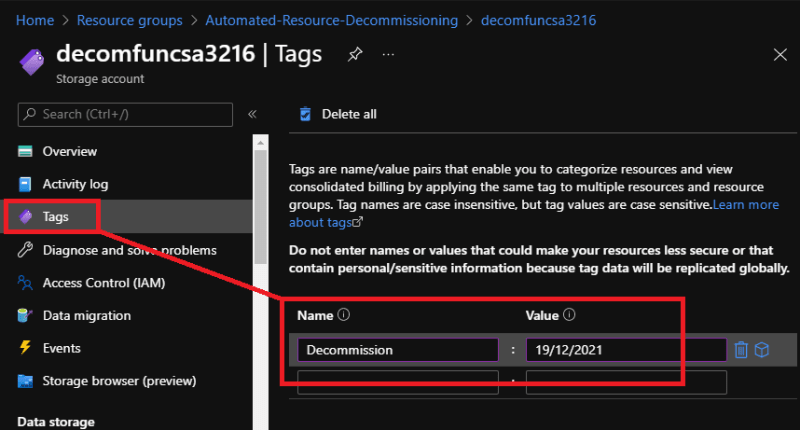
















Top comments (0)